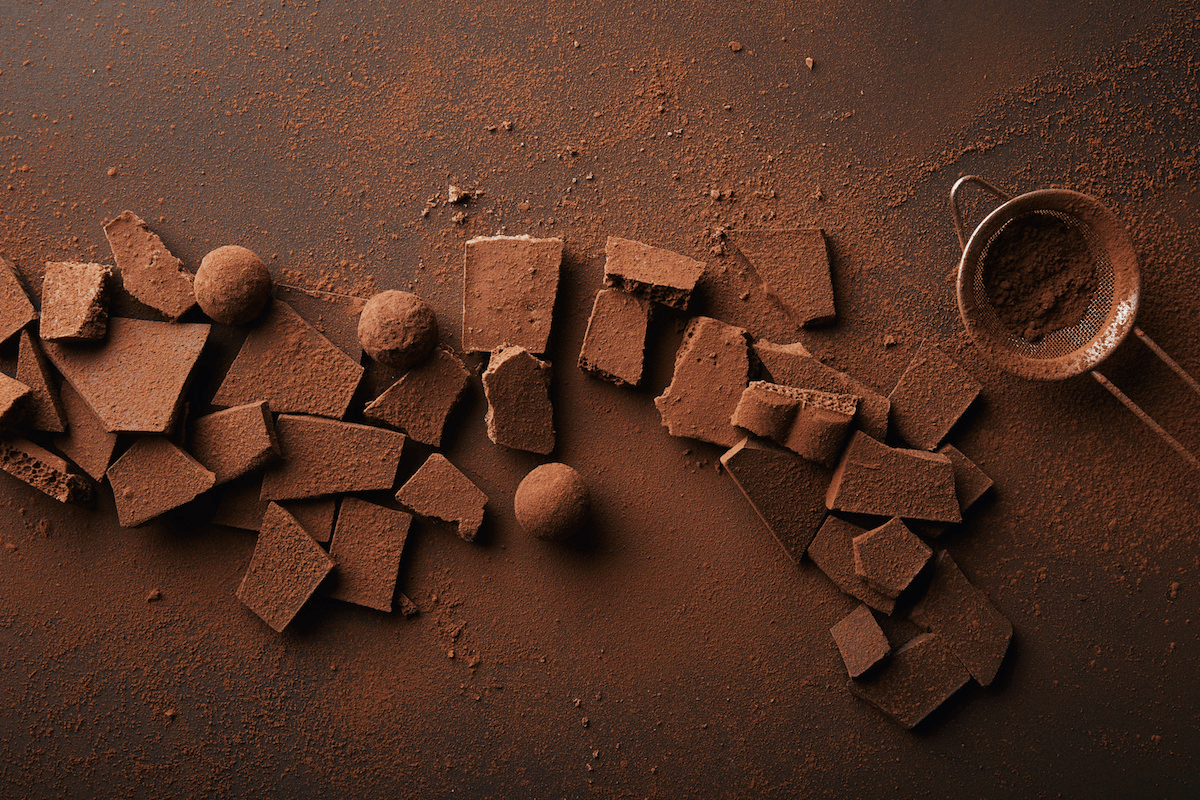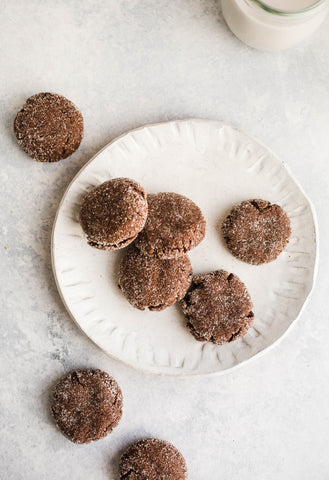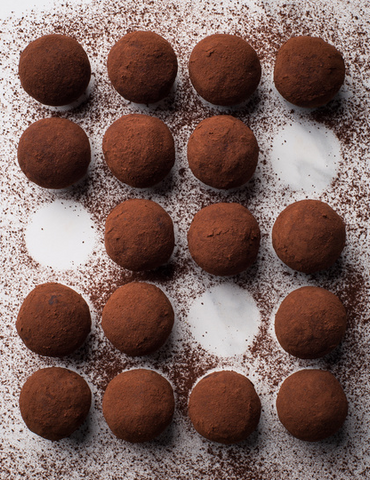
Dear Ruthy, What’s the difference between Cacao and Cocoa and should I only be using one or the other?
Cacao, Cocoa, chocolate — we understand it can get a little confusing understanding which is which, how they relate, and which has health benefits. Let’s dive in and unpack the differences so that you have a chocolatey grasp on the goods once and for all.
Early Beginnings
While Cacao and Cocoa start from the same place — they both come from the seeds of the fruit of the Theobroma Cacao tree — their final form (and the process they go through along the way) significantly affect their nutritional benefits. Raw Cacao beans (which somewhat resemble coffee beans) are the seeds extracted from the pods harvested from the Cacao tree.

(Photo from Salted Plains)
Cacao
Cacao, which has a slightly bitter taste, is healthiest in its raw state as it hasn’t undergone any high heating and therefore retains more nutrients and health properties. (Any raw food heated beyond approximately 105°F (the exact temperature depends on the diet you’re following and who you ask) begins to lose its nutritional value and can longer be considered raw).
Raw Cacao is the highest source of all the nutritional benefits associated with chocolate. It’s super-rich in antioxidants and packed with nutrients. In fact, it’s one of the highest food sources of magnesium – a mineral needed for hundreds of biochemical reactions in our bodies and key to muscle and nerve function. Studies even suggest that Cocoa flavanols might be associated with improved cognitive function.
Deep Dive: We need antioxidants to protect against free radicals, which are reactive molecules that can damage cells. Free radicals are created through normal metabolic processes, as well as through exposure to pollutants, toxins and other external stress factors. Antioxidants act as shields of protection, keeping our cells healthy and safe. Oxidative stress is a term used to describe a state of imbalance between damaging free radicals and protective antioxidants.
Cacao butter is the fattiest part of the Cacao bean that is separated and removed from the bean. It’s white and rich in texture and is a healthy fat (made up of mostly saturated fat, just like coconut oil). It can be used in baking or even as a moisturizer. If separated from the rest of the bean using low heat, its nutritional content is preserved and the resulting butter is referred to as “raw Cacao butter”. Once the raw Cacao butter is separated, the remaining Cacao mass is ground to produce raw Cacao powder, which can be used for numerous culinary purposes — everything from smoothies and other cold and hot beverages, to baking, puddings and fudge.

(Photo by Danika Zandboer)
Cocoa
Cocoa products differ from Cacao products, both in flavor and in health benefits. Cocoa (and Cocoa butter) are heated to much higher temperatures during processing. This results in a slightly sweeter flavor (in the case of the powder) — however, the high temperatures also result in lower nutritional value than that of raw Cacao.
Cocoa powder is commercially available in two main forms: “Dutch processed” Cocoa powder undergoes an additional chemical alkalizing process in order to make the product richer and less acidic, which is often desired for certain baking applications, but further strips it of any nutritional benefit.
“Natural” or “pure” Cocoa powder (or products simply labeled “Cocoa powder”) is more acidic and bitter than Dutch processed powder. In most chocolate products available in the grocery store (think hot chocolate and hot Cocoa, chocolate chips, chocolate cake, and chocolate liquor), you’ll find that the main chocolate ingredient used is Cocoa powder instead of Cacao.

(Photo from Salted Plains)
When To Use Cacao
Cacao is typically more expensive than Cocoa. Because of its less altered state, you’d definitely want to focus on using it when you want to get the health benefits of the pure Cacao bean.
That’s why we use Cacao powder that is organic, sustainably and ethically sourced from farmers in the Dominican Republic, and packed with health benefits.
Our Cacao products offer:
- Antioxidants. A favorite of anti-aging enthusiasts and the ultimate in protection against free radicals.
- Nutrients. Because we use raw Cacao powder in our Superblends, you’ll get the full nutrient load available.
We also blend our products with complementary herbs and functional mushrooms to help make sure you’re getting health benefits you’ll actually notice.
Bottom line: For any raw or low heat uses such as making smoothies and other beverages, puddings or homemade ice cream, or mixing into oatmeal or granola (after baking), stick to raw Cacao powder and raw Cacao nibs for the biggest nutritional bang! If you’re going to be baking or otherwise exposing the product to high heat, much of the nutritional benefit will be lost so you might not want to spend the extra chunk of change on raw Cacao. Cocoa powder will definitely do!
When To Use Cocoa
Just because it’s cheaper and less nutritious, that doesn’t mean Cocoa powder is inherently “bad.” It still contains some antioxidants, vitamins, and minerals — just not as many as Cacao. It can also be difficult to find good Cocoa powder unless you shop at a health food store.
That said, it sometimes makes more sense to use Cocoa powder. If you’re going to be baking or otherwise exposing the product to high heat, much of the nutritional benefit will be lost so you might not want to spend the extra chunk of change on raw Cacao. Cocoa powder will definitely do!
How To Kick Your Cocoa for Cacao
If it’s the health benefits you want, it’s Cacao you need. We’ve got resources that help you get more Cacao in your routine while simultaneously quenching the craving for chocolate.
Cacao on the Go
Sometimes you need a quick fix. For those moments, we have functional chocolate bars. At JOYÀ, we didn’t create just one bar — we crafted a family of bars that deliver the functional boosts you need each day.
- Balance. Find balance and fight stress with this 70% Cacao dark chocolate that features Cacao, Cacao Butter, Ashwagandha, and Reishi Mushroom.
- Defend. Supporting your immunity tastes as good as it feels with this blend of Cacao, Cacao Butter, Astragalus, and Lion’s Mane Mushroom.
- Zen. Reishi Mushroom, Chamomile, Coconut, Cacao, and Cacao Butter come together to create this zen-inducing indulgence.
- Focus. Rhodiola, Gingko, Coffee, Coconut, Cacao, and Cacao Butter team up to help you boost your productivity and squeeze more brain function into a busy day.
All JOYÀ functional chocolate bars are sweetened with coconut sugar in its purest form to help support your health goals and eliminate a dramatic spike and crash in blood sugar levels.
Cacao or Cocoa? Use What Brings You JOYÀ
You’ve got options when it comes to choosing your chocolate. Sometimes, using Cocoa just makes more sense. The rest of the time, give your body the good stuff.
Get your nutrients and pack in the health benefits in the form of Cacao, the ingredient closest to the Cacao plant and packed with the most nutrients. JOYÀ helps you get there easily with functional foods that are delicious and easy to add to your routine.
Sources:
Whipped Body Butter Recipe | Wellness Mama


Ruth Elnekave is a Toronto-based chef, holistic nutritionist, culinary instructor, recovering corporate lawyer and founder of JOYÀ. Her projects are fuelled by one main goal: to spread the pure joy and wellbeing experienced when sharing and savouring delicious, real food.
